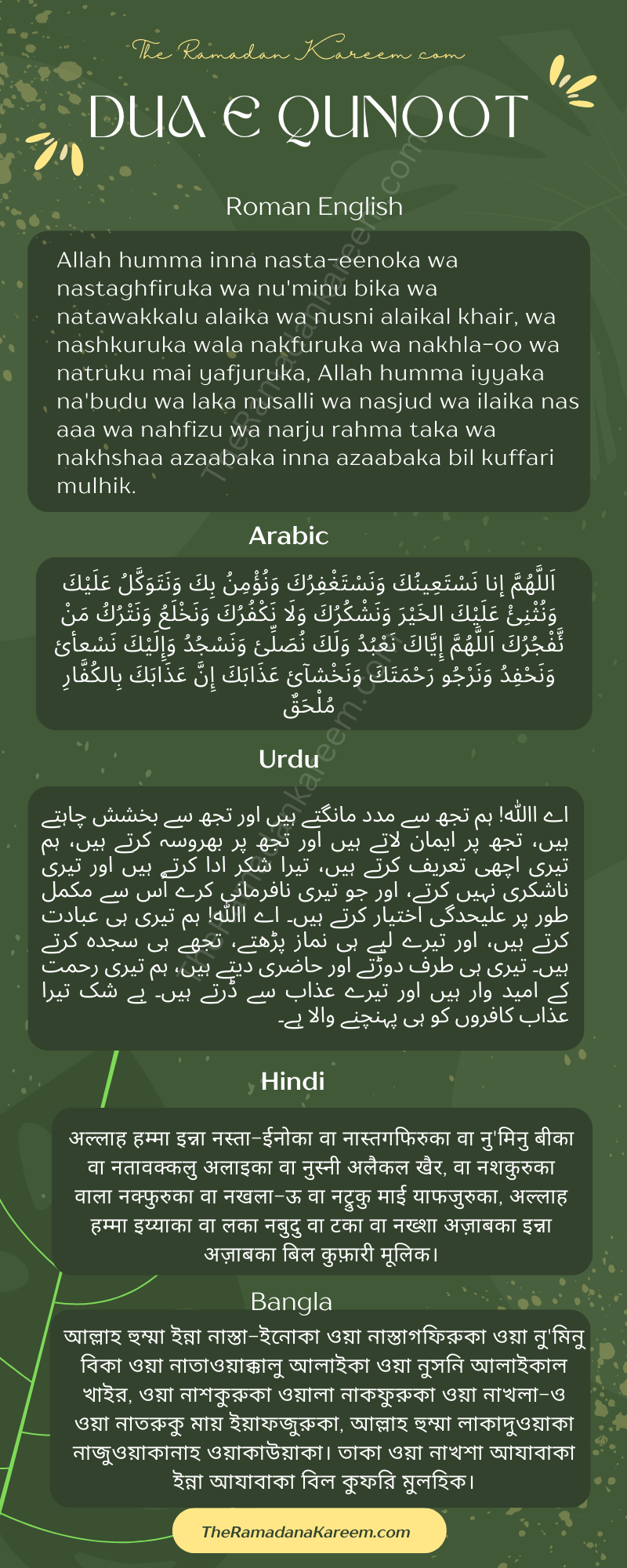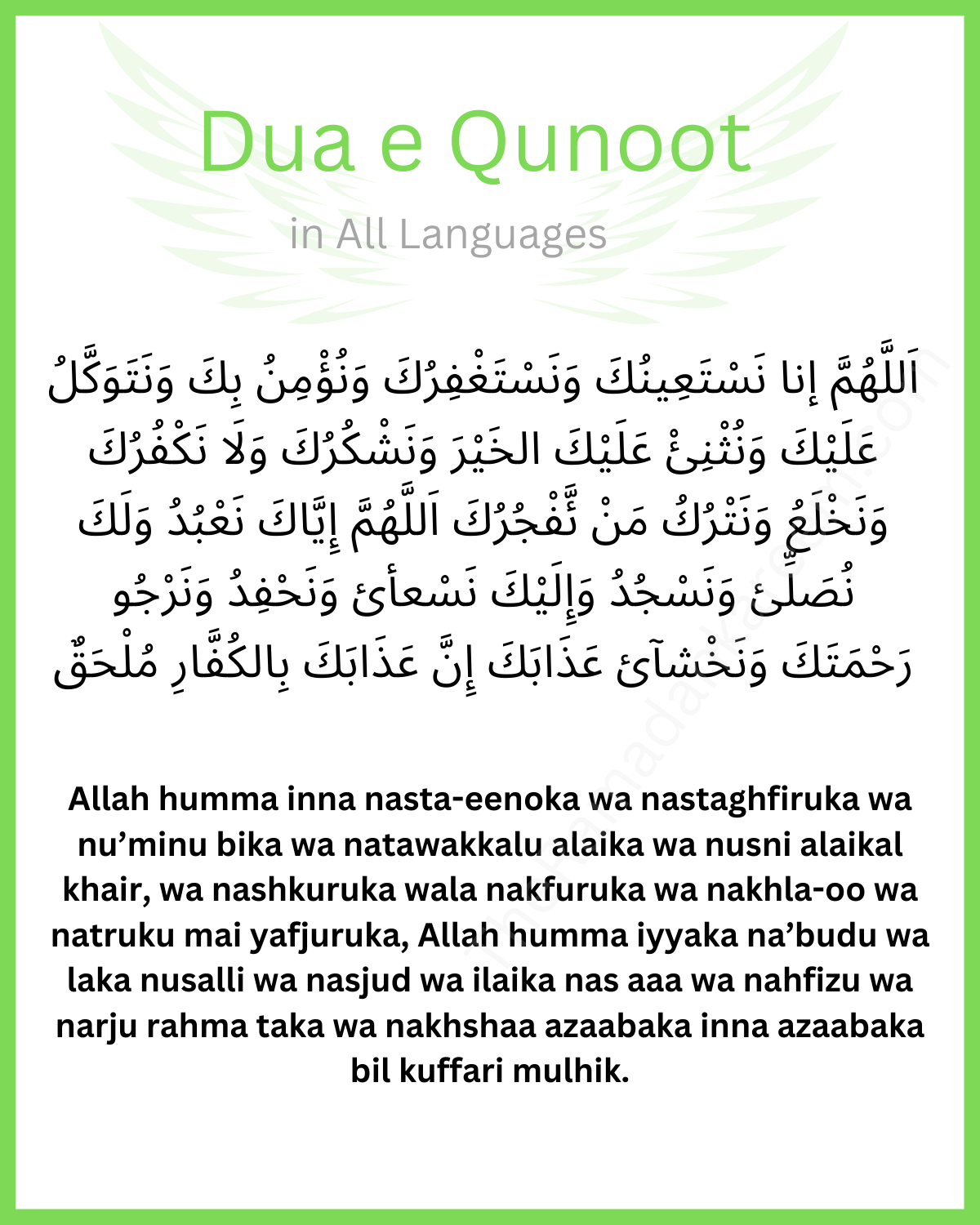Islam’s core element, obligatory prayer for all messengers and everyone, makes it abundantly clear that everyone needs to practice it. Different duas add meaning to your prayers, such as Dua e Qunoot Nazilah. Salaah, which itself is conducted five times each day at Fajr, Dhuhur, Asr, Maghrib, and Isha, is indeed a sacred responsibility for any and all Muslims. We use to read Qunoot in witr of Isha prayer.
Hum apko is article me full dua e qunoot from Quran with English, Roman English, urdu tarjuma, Hindi, Telugu, Arabic or different languages me meaning k sath dain gy. Ap is dua ko PDF image me download v kr skty hen. Hanfi, Barelvi, Sunni, Shia, Fiqa Jafria people also use Qunoot Nazilah for protection from harm.
We can deepen our relationship with the Creator of all that exists, Allah, by saying prayers, which is a beautiful means of communicating with Allah the almighty. Fajr and Isha are considered to be one of the parameters to evaluate the differences between Munafiqeen, who are backstabbers of religion, and Momineen. They really are true people of faith. All prayers are unquestionably extremely relevant in Islam, however, and therefore are frequently employed to differentiate between the two categories.
Dua E Qunoot In Arabic:

Dua E Qunoot In English & Roman English:
Hindi Translation:
Urdu Tarjuma Translation:
Dua E Qunoot Translation In English:
At-Tirmidhi: 464, Abu Dawud: 1425
Bangla Meaning:
Teluglu Meaning:
Shia k liye dua e qunoot:

Gujarati Qunoot Nazilah Translation:
અમે ભારતીય લોકો માટે ગુજરાતી ભાષામાં દુઆ એ કુનૂત લખીશું.
Dua E Qunoot: What Is It? – Meaning
The Islamic type of standing prayer termed Dua e Qunoot is a petitioning supplication. Using the Sunnah’s Witr as a reference, you can pray fervently by offering it.
The term Qunoot is characterized as “the gesture of standing upright” in Dua e Qunoot, which implies “staying faithful.” The Arabic word for praying is titled dua. Its concept comprises notions like obedience, modesty, and dedication. One particular dua that is recited during the Isha prayer is Dua e Qunoot.
Background Of Dua E Qunoot
Hasan ibn Ali acquired this petition from the Prophet Mohammed (PBUH), as per Muhammad ibn ‘Isa at-Tirmidhi, Ahmad, and Abu Dawood. Dawood further claimed that Hazrat Muhammad (S.A.W) would continue repeating this dua every time Muslims suffered extreme danger or tragedy.
The Holy Prophet (PBUH) handed me this dua and recommended that I utter it during the Witr prayers, Ibn Ali added. All across the period of the year, the Prophet Muhammad (S.A.W) recited Dua e Qunoot at Witr and Fajr and also frequently during the other petitions.
When Should You Recite The Dua E Qunoot?
It is acceptable to recite Dua e Qunoot before turning during the last Rakah of Witr recitation, which must occur after kneeling. Yet, it is best to utter it after bowing.
About Dua e Qunoot, there seem to be three conflicting extremities and one middle (or moderate) approach. Several narrators believe that one needs to recite dua e Qunoot before bowing.
Additionally, some claim that the requestor must only repeat it after bowing (rukoo).
Advantages Of Dua E Qunoot – Fazilat
- It aids in the improvement of our visual function.
- We can enhance the Barakah in our homes, income, as well as other fields with the help of Dua e Qunoot.
- It aids in increasing the chances that Salah will be offered adequately.
- It aids in boosting our ambition to live healthier lifestyles.
Conclusion:
One of the greatest benefits in this life is to have a strong relationship with Allah. Praying and making supplications to Allah should be your primary focus if you want to maintain a connection with him. In order to demonstrate our commitment to and love for Allah, the Prophet Muhammad (PBUH) provided us with instructions on the Dua e Qunoot.

